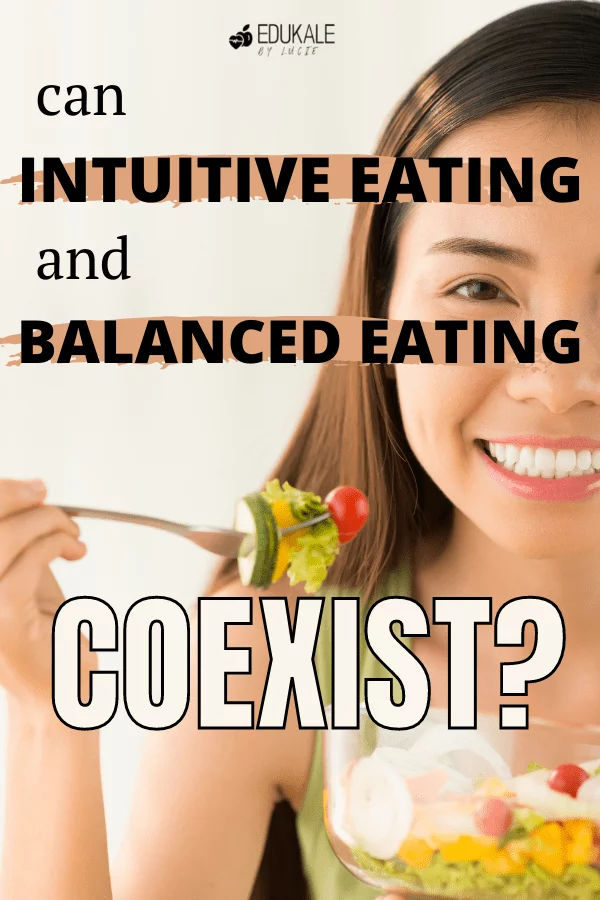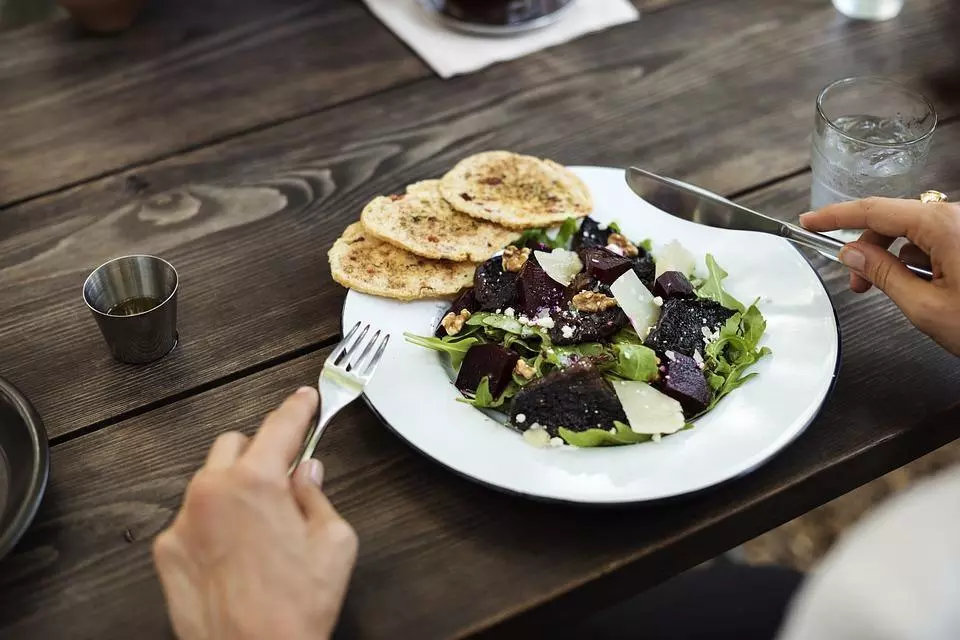This post contains affiliate links from which I may receive a small commission, at no extra cost to you. In no way does this affect my opinion or the information I provide on the product. Please read my disclaimer for more info.
Contrary to popular belief, intuitive eating doesn’t mean eating whatever you want whenever you want.
There are actually ten principles to intuitive eating. The last one is called gentle nutrition and involves making food choices that honor your health all while making you feel good.
So can balanced eating and intuitive eating coexist? Absolutely— here’s how.

Remember the basics of intuitive eating
Intuitive eating is an evidence-based way of eating that promotes a healthy relationship with food. It focuses on your body’s internal signals to meet your needs, instead of outside rules and restrictions.
It has ten principles, including rejecting diet mentality, honoring your hunger, feeling your fullness, challenging the food police, discovering satisfaction…
You need to integrate these principles and keep them in mind before attempting to create balanced meals. Check out my article on intuitive eating and its principles for more information!

Incorporate the basics of balanced eating
Once you have integrated these principles, you can learn to make balanced meals. In short, a balanced meal provides all the nutrients you need without over-consuming calories and should involve many different food groups.
If you have no idea what that looks like, you can use the plate method as a guide—and I insist on the word guide because you don’t want to overrule the intuitive eating aspect.
This is to steer you in the right direction if you have no idea what balanced eating looks like, but it shouldn’t feel overwhelming or distance you from intuitive eating.
In a nutshell, the plate method involves filling up around half of your plate with veggies (greens, raw veggies…) one-fourth of your plate with protein (chicken, fish, tofu, beans, lentils…), and one-fourth of it with carbs (whole grains, starchy veggies…)
You should also make sure that you’re getting in healthy fats, calcium, and plenty of water! This method enables you to get the nutrients you need without tracking or measuring anything.
Check out my article on creating a healthy plate for more information!
Give yourself options
Figuring out what you crave and want to eat can become overwhelming. To make it a little easier, you can give yourself categories to choose your food from.

For instance, you can have a carb category, a vegetable category, and a protein category, and pick elements within these. You can also make smaller categories within them, like a beans and legumes category, a starchy veggies category, a whole grains category, etc.
Think about which food sounds best to you in each category, then about whether they sound good together or not. Do you want to switch it up? Is there anything else you feel like eating more?
Be flexible with your meals
While it’s important to have these notions, they should never come before what your body is telling you. This is why being very flexible with your food choices is crucial.
For instance, if you’re craving a big plate of pasta and don’t feel like bothering with veggies or protein, you can totally honor that and balance it out later on (more on that right after).
Similarly, if you prepared a meal and you’re not craving it anymore when dinner-time comes, it’s ok to make something different.
If you don’t feel like eating the entire meal you made for yourself, it’s possible to save some for later, and likewise, if you want more than what you initially prepared for yourself, that’s ok too.
It can be helpful to have general meal ideas in mind for the week with all the ingredients necessary. Then, when mealtime comes around, let yourself decide which meal you feel like having the most.
Balance your meals over a few days
It can be difficult to practice intuitive eating if you’re trying to get a perfectly balanced plate for every single meal. A great way to add the flexibility that we’re looking for is to balance your meals throughout the day or over a few days.
This can look like eating pizza on Friday night because that’s what you were craving, and then having a vegetable omelet with fruit for breakfast instead of the pancakes you usually have.
It can also look like having a salad with a bunch of veggies and tofu for lunch, but making sure you’re getting in enough carbs at dinner with a big bowl of noodles.
Make sure that you’re always checking in with yourself and what you want before each meal. The intent behind it is very important.
You don’t want to be punishing yourself for a meal that wasn’t balanced or healthy, and you don’t want to “save your calories” in preparation for the bigger meal to come. If you find yourself thinking this way, it’s important to take a step back and do some more work on the other intuitive eating principles.
What you should be aiming for instead is making your body feel good. For instance, replenishing it with fruit and veggies after a delicious and satisfying but less nutrient-heavy pizza is a great way to see it.
Focus on the small, easy things you can add
If you’re craving a certain food or meal, ask yourself if you can make it more nutritiously balanced without reducing its pleasure or satisfaction.
If you’re craving a big plate of pasta, are you able to add some cherry tomatoes and thinly diced tofu with herbs to it and still get the satisfaction you want from it?
If you really want a fresh veggie salad, can you eat it with some whole grain bread and add nuts to it without reducing the pleasure it brings?

Basically, if you’re able to add more nutrition or balance to a meal without compromising the taste, and if you’re still getting as much pleasure from it, then go for it! If not, you can enjoy your meal as is and focus on balancing it out later on, as we discussed above.
Choose foods that bring both pleasure and health
As I mentioned previously, there’s a misconception that intuitive eating is solely about eating whatever you want whenever you want, regardless of nutrition, health, or how your body feels.
In reality, it’s a little more complex than that, and mindful eating can definitely be a part of intuitive eating. The way I like to see it is through a Venn diagram. One circle is the food you really like, and one circle is the food that is healthy and nutritious.
Around 70% of your meals should fall where the circles intersect, so foods that are both healthy and enjoyable to you. 30% of the time, you may eat foods that you really enjoy but that aren’t the healthiest, or foods that are really healthy but that you don’t love.

Can balanced eating and intuitive eating coexist (in short!)
So intuitive eating and balanced eating definitely aren’t incompatible — hopefully this article can help bridge the gap between them!
I also want you to remember that intuitive eating is a personal journey— you need to take the time to figure out what works for you.
-Lucie
If you’re interested in nutrition, its impact on our health, and the science behind it, you should definitely read How Not to Die. In this book, Doctor Michael Greger, founder of Nutrition Facts, examines the top causes of death in America and explains how your diet can prevent— and in some cases even reverse— them. His advice is all backed by science and he writes in a very clear and entertaining way. This book isn’t a list of what you already know. It will teach you the keys to living a long healthy life, in a simple and practical way, and without spending fortunes on supplements and pills!
PLUS if you want to take it a step further, you can check out the How Not to Die Cookbook to implement the advice easily!


